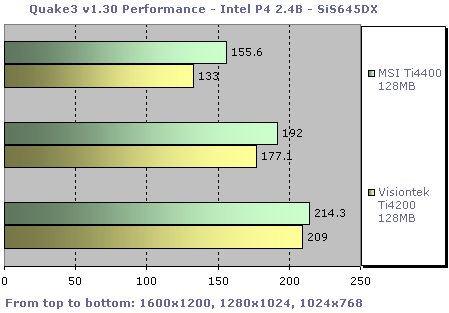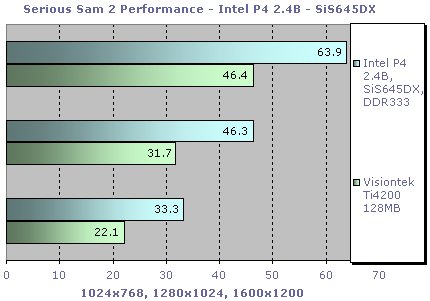|
Quake3 has been strong on NVIDIA hardware since NV15/GeForce2 and it certainly hasn't got slower on GeForce4. Being a pseudo-DX6 class game in terms of rendering requirements, we're looking for excellent performance at all resolutions.

Not much to comment on that we haven't seen before with other NV25's but it's worth a sentence or two. At lower resolutions, the two scores bunch up closer since it's all about system throughput at those settings. The cards are sat waiting on data more than at higher resolutions so performance is close. It's only at the highest resolution of 1600x1200 that the Ti4400 shows any kind of real world tangible advantage and even then, is 133fps from the Ti4200 really that slow?
What about Serious Sam 2? Similar rendering requirements, no reliance on shader hardware, just on a fast multitexture capable card with the more texture ops per rendering pass the better. NV25 acts like a fast NV20 in Serious Sam 2 so imagine a GF3 at 250/444 for the Ti4200 scores and the same with the Ti4400. This is down to the number of passes the engine does on the hardware, a slight hiccup on Croteams part since the NV25 could be made faster.

This graph looks misleading since the gap between the two cards looks bigger the lower the resolution, the opposite of what we expect (the faster card gets faster as it gets made to do more work) but if you examing the percentages, you see that Ti4400 is proportionally quicker as the work gets harder. This shows the GPU scales well doing SS2 style rendering.
All in all, strong performance from the Ti4200 and with SS2 making use of a lot of textures per scene, especially in the outdoor levels, the larger framebuffer helps. Of course it is offset by the lower memory clock compared to 64MB cards but it's nice to have and there's certainly a case to be made for smoother performance, if not as fast, over a 64Mb model.
Think about texture buffering and flushing by the driver when the scene is being generated and destroyed and when the memory needed gets bigger than the framebuffer, the case for a larger framebuffer can be made.
Finally in our look at performance, lets have a look at Comanche 4 from Novalogic.
|